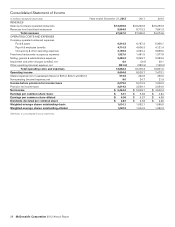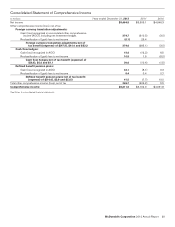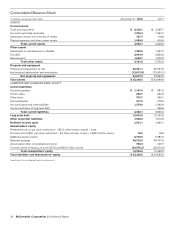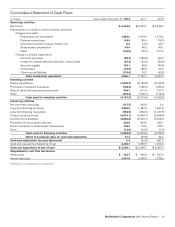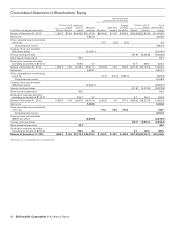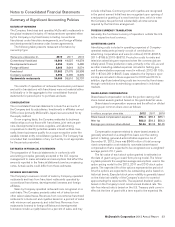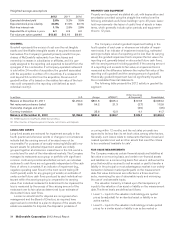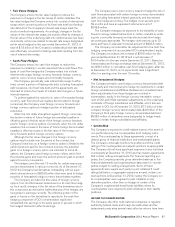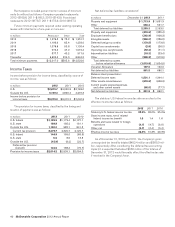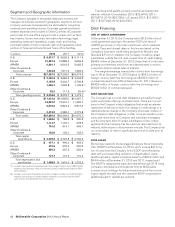McDonalds 2012 Annual Report Download - page 35
Download and view the complete annual report
Please find page 35 of the 2012 McDonalds annual report below. You can navigate through the pages in the report by either clicking on the pages listed below, or by using the keyword search tool below to find specific information within the annual report.
Notes to Consolidated Financial Statements
Summary of Significant Accounting Policies
NATURE OF BUSINESS
The Company franchises and operates McDonald’s restaurants in
the global restaurant industry. All restaurants are operated either
by the Company or by franchisees, including conventional
franchisees under franchise arrangements, and foreign affiliates
and developmental licensees under license agreements.
The following table presents restaurant information by
ownership type:
Restaurants at December 31, 2012 2011 2010
Conventional franchised 19,869 19,527 19,279
Developmental licensed 4,350 3,929 3,485
Foreign affiliated 3,663 3,619 3,574
Franchised 27,882 27,075 26,338
Company-operated 6,598 6,435 6,399
Systemwide restaurants 34,480 33,510 32,737
The results of operations of restaurant businesses purchased
and sold in transactions with franchisees were not material either
individually or in the aggregate to the consolidated financial
statements for periods prior to purchase and sale.
CONSOLIDATION
The consolidated financial statements include the accounts of
the Company and its subsidiaries. Investments in affiliates owned
50% or less (primarily McDonald’s Japan) are accounted for by
the equity method.
On an ongoing basis, the Company evaluates its business
relationships such as those with franchisees, joint venture part-
ners, developmental licensees, suppliers, and advertising
cooperatives to identify potential variable interest entities. Gen-
erally, these businesses qualify for a scope exception under the
variable interest entity consolidation guidance. The Company has
concluded that consolidation of any such entity is not appropriate
for the periods presented.
ESTIMATES IN FINANCIAL STATEMENTS
The preparation of financial statements in conformity with
accounting principles generally accepted in the U.S. requires
management to make estimates and assumptions that affect the
amounts reported in the financial statements and accompanying
notes. Actual results could differ from those estimates.
REVENUE RECOGNITION
The Company’s revenues consist of sales by Company-operated
restaurants and fees from franchised restaurants operated by
conventional franchisees, developmental licensees and foreign
affiliates.
Sales by Company-operated restaurants are recognized on a
cash basis. The Company presents sales net of sales tax and
other sales-related taxes. Revenues from conventional franchised
restaurants include rent and royalties based on a percent of sales
with minimum rent payments, and initial fees. Revenues from
restaurants licensed to foreign affiliates and developmental
licensees include a royalty based on a percent of sales, and may
include initial fees. Continuing rent and royalties are recognized
in the period earned. Initial fees are recognized upon opening of
a restaurant or granting of a new franchise term, which is when
the Company has performed substantially all initial services
required by the franchise arrangement.
FOREIGN CURRENCY TRANSLATION
Generally, the functional currency of operations outside the U.S.
is the respective local currency.
ADVERTISING COSTS
Advertising costs included in operating expenses of Company-
operated restaurants primarily consist of contributions to
advertising cooperatives and were (in millions): 2012–$787.5;
2011–$768.6; 2010–$687.0. Production costs for radio and
television advertising are expensed when the commercials are
initially aired. These production costs, primarily in the U.S., as well
as other marketing-related expenses included in Selling, gen-
eral & administrative expenses were (in millions): 2012–$113.5;
2011–$74.4; 2010–$94.5. Costs related to the Olympics spon-
sorship are included in these expenses for 2012 and 2010. In
addition, significant advertising costs are incurred by franchisees
through contributions to advertising cooperatives in individual
markets.
SHARE-BASED COMPENSATION
Share-based compensation includes the portion vesting of all
share-based awards granted based on the grant date fair value.
Share-based compensation expense and the effect on diluted
earnings per common share were as follows:
In millions, except per share data 2012 2011 2010
Share-based compensation expense $93.4 $86.2 $83.1
After tax $63.2 $59.2 $56.2
Earnings per common share-diluted $0.06 $0.05 $0.05
Compensation expense related to share-based awards is
generally amortized on a straight-line basis over the vesting
period in Selling, general & administrative expenses. As of
December 31, 2012, there was $94.6 million of total unrecog-
nized compensation cost related to nonvested share-based
compensation that is expected to be recognized over a weighted-
average period of 2.1 years.
The fair value of each stock option granted is estimated on
the date of grant using a closed-form pricing model. The follow-
ing table presents the weighted-average assumptions used in the
option pricing model for the 2012, 2011 and 2010 stock option
grants. The expected life of the options represents the period of
time the options are expected to be outstanding and is based on
historical trends. Expected stock price volatility is generally based
on the historical volatility of the Company’s stock for a period
approximating the expected life. The expected dividend yield is
based on the Company’s most recent annual dividend rate. The
risk-free interest rate is based on the U.S. Treasury yield curve in
effect at the time of grant with a term equal to the expected life.
McDonald’s Corporation 2012 Annual Report 33







